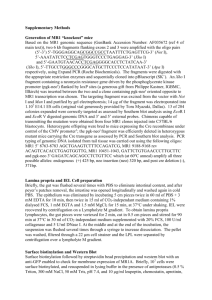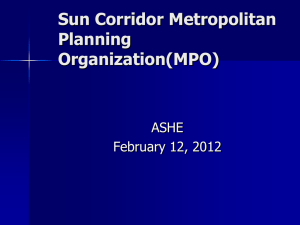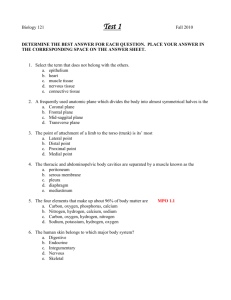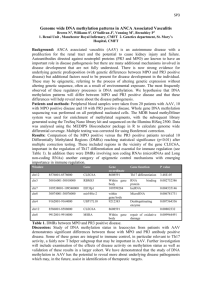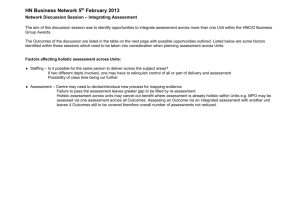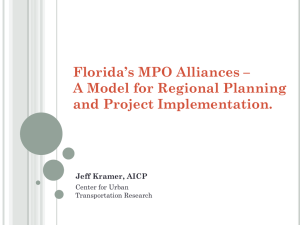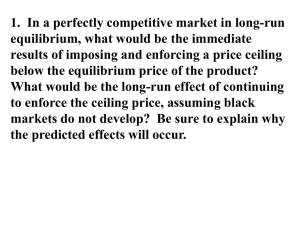bio_121_test2_blueprint_results
advertisement
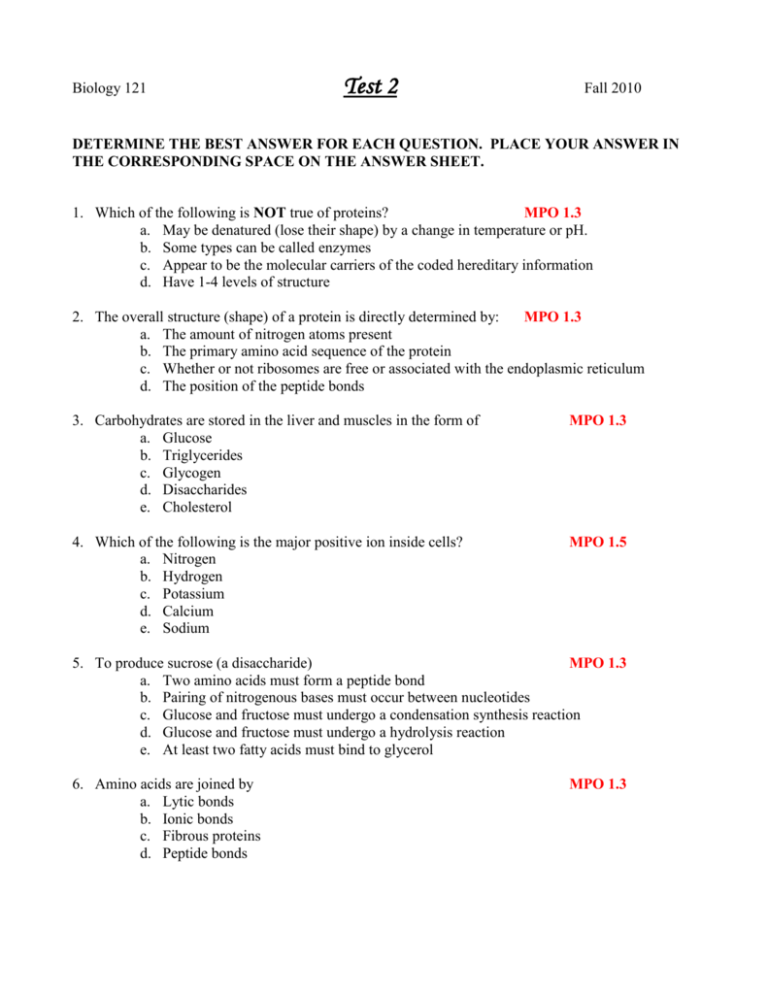
Biology 121 Test 2 Fall 2010 DETERMINE THE BEST ANSWER FOR EACH QUESTION. PLACE YOUR ANSWER IN THE CORRESPONDING SPACE ON THE ANSWER SHEET. 1. Which of the following is NOT true of proteins? MPO 1.3 a. May be denatured (lose their shape) by a change in temperature or pH. b. Some types can be called enzymes c. Appear to be the molecular carriers of the coded hereditary information d. Have 1-4 levels of structure 2. The overall structure (shape) of a protein is directly determined by: MPO 1.3 a. The amount of nitrogen atoms present b. The primary amino acid sequence of the protein c. Whether or not ribosomes are free or associated with the endoplasmic reticulum d. The position of the peptide bonds 3. Carbohydrates are stored in the liver and muscles in the form of a. Glucose b. Triglycerides c. Glycogen d. Disaccharides e. Cholesterol MPO 1.3 4. Which of the following is the major positive ion inside cells? a. Nitrogen b. Hydrogen c. Potassium d. Calcium e. Sodium MPO 1.5 5. To produce sucrose (a disaccharide) MPO 1.3 a. Two amino acids must form a peptide bond b. Pairing of nitrogenous bases must occur between nucleotides c. Glucose and fructose must undergo a condensation synthesis reaction d. Glucose and fructose must undergo a hydrolysis reaction e. At least two fatty acids must bind to glycerol 6. Amino acids are joined by a. Lytic bonds b. Ionic bonds c. Fibrous proteins d. Peptide bonds MPO 1.3 7. Cells try to move sodium ions from the cytoplasm to the outside of the cell, where the sodium concentration is 14 times higher than in the cytoplasm. This means sodium ions are moved out of the cell by MPO 1.4 a. Simple diffusion b. Facilitated diffusion c. Osmosis d. Active transport e. Filtration 8. An organelle which varies in number in direct proportion to the energy needs of the cell is a a. Nucleus MPO 1.5 b. Nucleolus c. ATP d. Mitochondrion e. Golgi complex 9. Neutral fats have a _____ ratio of fatty acids to glycerol. a. 1:1 b. 2:1 c. 3:1 d. 4:1 MPO 1.3 10. DNA replication occurs in the a. M phase of the cell cycle b. Prophase c. Interphase d. Cytokinesis phase of the cell cycle e. G phase of the cell cycle 11. The RNA responsible for bringing the amino acids to the factory site for protein synthesis is the a. rRNA MPO 1.5 b. mRNA c. tRNA d. ssRNA 12. The plasma membrane is important for which of the following reasons a. It is selectively permeable b. It defines the boundaries of the cell c. It acts as a site for cell-to-cell interaction and recognition d. All of the above are correct MPO 1.4 13. Which of the following processes/characteristics would be affected by the absence of microtubules? MPO 1.5 a. Motility b. The arrangement of cell organelles c. Cell division d. All of the above would be affected 14. What can you tell about the following nucleotide (nitrogenous base) sequence: ADENINE-URACIL-GUANINE MPO 1.5 a. It could be part of DNA b. It could be part of RNA c. A complementary strand of RNA nucleotides would be THYMINE-ADENINECYTOSINE d. The bases are linked by peptide bonds e. Both A and C are correct 15. During the process of translation, the code carried by mRNA is a. Turned into DNA b. Decoded into a protein c. Decoded into a pentose d. Used to manufacture tRNA MPO 1.5 16. Simple diffusion MPO 1.4 a. Occurs from regions of higher to lower concentrations by the interaction of solute molecules with specific membrane transport systems b. Moves a substance from an area of lower concentration to an area of higher concentration against its concentration gradient c. Is a process involving the unaided net movement of a substance from a region of higher concentration to a region of lower concentration d. Can only take place across a living cell membrane 17. A “saturated fat” is saturated with a. Hydrogen b. Aluminum c. Carbon d. Iron e. Oxygen MPO 1.3 18. All proteins destined for export from the cell follow a similar route. Which of the following is the correct sequence of events for the protein after it is synthesized by the ribosome? MPO 1.5 a. RER → transport vesicles → secretory vesicles → Golgi complex → released via exocytosis b. Secretory vesicles → RER → Golgi complex → transport vesicles → released via exocytosis c. Golgi complex → secretory vesicles → transport vesicles → RER → released via exocytosis d. RER → transport vesicles → Golgi complex → secretory vesicles → released via exocytosis e. Transport vesicles → RER → secretory vesicles → Golgi complex → released via exocytosis 19. Which of the following is NOT a type of protein filament which comprises the cytoskeleton? a. Intermediate filaments MPO 1.5 b. Macrotubules c. Microfilaments d. Microtubules 20. _____ is an essential component of the cell membrane but is infamous for its relationship to “hardening of the arteries”. MPO 1.4 a. Prostaglandin b. Estrogen c. Eicosanoid d. Cholesterol 21. Once solid material is phagocytized and taken into a vacuole, which of the following statements best describes what happens? MPO 1.5 a. A ribosome enters the vacuole and uses the amino acids from the “invader” to form new protein b. A lysosome combines with the vacuole and digests the enclosed solid material c. The vacuole remains separated from the cytoplasm and the solid material persists unchanged d. Oxygen inters the vacuole and “burns” the enclosed solid material 22. Denaturation of a protein always results in a. Loss of biological function b. Addition of new amino acids to the molecule c. Destruction of the primary structure d. Formation of new hydrogen bonds e. Stimulation of new protein synthesis MPO 1.3 23. Carrier molecules within the cell membrane are required in order to transport a substance across a membrane via MPO 1.4 a. Osmosis b. Filtration c. Facilitated diffusion d. Simple diffusion 24. Cell membrane receptors are usually what type of molecules? a. Phospholipid b. Protein c. Cholesterol d. Nucleic acid MPO 1.4 (25-28). Name the phase of mitosis during which each of the following events takes place. 25. Spindle fibers begin to form. 26. Chromosomes first become visible as bar-like bodies. 27. Nuclear membrane and nucleolus reappear. 28. Chromosomal centromeres split and chromosomes migrate to opposite ends of the cell. 29. You are using a compound microscope with a total magnification of 500x. The oculars are standard magnification. What is the magnification of the objective lens? 30. _____ is the change that a cell undergoes from an un-specialized one to a specialized one. a. Differentiation b. Metabolism c. Movement d. Reproduction e. Responsiveness (31-32). The picture below shows diffusion in an agar plate set-up. 31. Which substance moved faster? 32. Why did that substance move faster? (33-38). In the figure below, identify the shape of the RBC, and the type of solution the RBC is in. The large arrows show the net water movement. 33, 34 35, 36 MPO 1.4 MPO 1.4 37, 38 MPO 1.4 (39-46). The figure below shows the molecular structure of DNA. Adenine = A, Cytosine = C. 39, 40. Identify the two unnamed nitrogen bases by their single letter abbreviations and full names. 4848 41, 42, 43, 44. Identify the numbered bases on the diagram. 45. Name the bonds that help hold the two DNA strands together. 46. Name the three-dimensional shape of the DNA molecule. MPO 1.3 (39 – 46) (47-48). The figure below is a portion of a plasma membrane. 47. Which label, B or C, indicates the nonpolar region of a phospholipid molecule? 48. Which label, D or E, indicates an integral membrane protein? MPO 1.4 (47 – 48) 49. DNA could code for the synthesis of only one of the following, namely MPO 1.5 a. testosterone b. Glycogen c. Collagen d. Phospholipids e. Fats 50. Protein synthesis involves an anticodon, a base triplet, and a codon. These are parts of the _______ molecules, respectively. MPO 1.5 a. tRNA, DNA, and mRNA b. DNA, tRNA, and mRNA c. mRNA, rRNA, and tRNA d. DNA, RNA, and polypeptide e. RNA, DNA, and polypeptide Bonus Question: Name and describe the four phases of mitosis in sequence. Write your answer in the space below. (6 points) Biology 121 – Test 2 Data obtained October 12, 2010 N = 43 Question # 1 2 3 4 5 6 7 8 9 11 12 13 14 15 16 17 18 19 20 21 22 23 24 33 34 35 36 37 38 39 40 41 42 43 44 45 47 48 49 50 MPO 1.3 MPO 1.3 1.3 1.3 1.5 1.3 1.3 1.4 1.5 1.3 1.5 1.4 1.5 1.5 1.5 1.4 1.3 1.5 1.5 1.4 1.5 1.3 1.4 1.4 1.4 1.4 1.4 1.4 1.4 1.4 1.3 1.3 1.3 1.3 1.3 1.3 1.3 1.3 1.4 1.4 1.5 # Correct 26 23 17 17 14 39 18 27 14 25 40 31 30 17 20 20 26 24 36 31 13 23 13 26 13 25 14 15 14 26 26 29 27 27 34 20 35 30 10 12 MPO 1.4 Percentage 60 53 40 40 33 91 42 63 33 58 93 72 70 40 47 47 60 56 84 72 30 53 30 60 30 58 33 35 33 60 60 67 63 63 79 47 81 70 23 28 Average for same MPO 56.7 49.4 55.9 MPO 1.5
